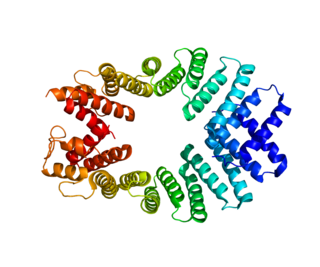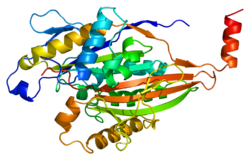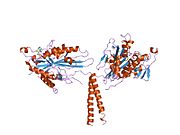
The human gene SPAST codes for the microtubule-severing protein of the same name, commonly known as spastin.

Kinesin family member 5B (KIF5B) is a protein that in humans is encoded by the KIF5B gene.

Kinesin light chain 1 is a protein that in humans is encoded by the KLC1 gene.

Kinesin-like protein KIF3A is a protein that in humans is encoded by the KIF3A gene.

Kinesin-like protein KIF21A is a protein that in humans is encoded by the KIF21A gene.

Kinesin light chain 2 is a protein that in humans is encoded by the KLC2 gene.

Paraplegin is a protein that in humans is encoded by the SPG7 gene located on chromosome 16.

Spartin is a protein that in humans is encoded by the SPG20 gene.

Non-imprinted in Prader-Willi/Angelman syndrome region protein 1 is a protein that in humans is encoded by the NIPA1 gene. This gene encodes a potential transmembrane protein which functions either as a receptor or transporter molecule, possibly as a magnesium transporter. This protein is thought to play a role in nervous system development and maintenance. Alternative splice variants have been described, but their biological nature has not been determined. Mutations in this gene have been associated with the human genetic disease autosomal dominant spastic paraplegia 6.

Kinesin light chain 3 is a protein that in humans is encoded by the KLC3 gene.

Kinesin-like protein KIF1C is a protein that in humans is encoded by the KIF1C gene. Kif1C is a fast, plus-end directed microtubule motor. It takes processive 8nm steps along microtubules and can generate forces of up to 5 pN. Kif1C transports α5β1-integrins in human cells. Kif1C has been shown to be non-essential in mouse with other proteins able to perform the same function. However, mutations in KIF1C lead to spastic paraplegia and cerebellar dysfunction in humans. These mutations usually result in a total loss of the protein or (partial) loss of function, such as significant lower force output.

Kinesin heavy chain isoform 5C is a protein that in humans is encoded by the KIF5C gene.

Kinesin-like protein KIF17 is a protein that in humans is encoded by the KIF17 gene. KIF17 and its close relative, C. elegans OSM-3, are members of the kinesin-2 family of plus-end directed microtubule-based motor proteins. In contrast to heterotrimeric kinesin-2 motors, however, KIF17 and OSM-3 form distinct homodimeric complexes. Homodimeric kinesin-2 has been implicated in the transport of NMDA receptors along dendrites for delivery to the dendritic membrane, whereas both heterotrimeric and homodimeric kinesin-2 motors function cooperatively in anterograde intraflagellar transport (IFT) and cilium biogenesis.

Kinesin-like protein KIF3C is a protein that in humans is encoded by the KIF3C gene.

Kinesin-like protein KIF1A, also known as axonal transporter of synaptic vesicles or microtubule-based motor KIF1A, is a protein that in humans is encoded by the KIF1A gene.

Fatty acid 2-hydroxylase is a protein that in humans is encoded by the FA2H gene.

Kinesin family member 15 is a protein that in humans is encoded by the KIF15 gene.

Acetyl-coenzyme A transporter 1 also known as solute carrier family 33 member 1 (SLC33A1) is a protein that in humans is encoded by the SLC33A1 gene.

Zinc finger, FYVE domain containing 26 is a protein that in humans is encoded by the ZFYVE26 gene.

Zinc finger, FYVE domain containing 27 is a protein that in humans is encoded by the ZFYVE27 gene.






















